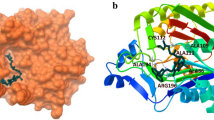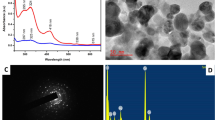Abstract
A glucose−lysine (Glu−Lys) Maillard reaction mixture heated at 121°C for 60 min was processed by ultrafiltration, ethyl acetate extraction, and semi-preparative HPLC to recover a bioactive fraction, termed F3. F3, characterized by spectral analysis to contain three distinct components, inhibited NO and IL-8 by 70 and 61%, respectively, at a concentration of 50 μg/ml in inflamed Caco-2 cells induced by IFN-γ and phorbol 12-myristate 13-acetate (PMA). F3 significantly (P < 0.05) down-regulated several genes involved in nuclear factor kappa B (NF-κB) signaling pathway. These genes included the cytokine receptors, TNFRSF10A and TNFRSF10B; receptor-associated proteins, IRAK2 and TICAM1; the inhibitor κB kinase, IKBKE; the NF-κB inhibitor, NFKBIA; and the NF-κB subunits, REL, RELA, and RELB. F3 also down-regulated the NF-κB responsive genes IL-8, NOS2, and ICAM1, attenuated the gene expression of peroxidases such as DUOX1 and DUOX2, and relieved the down-regulated GCFHR that are involved in the biosynthesis of NO and TROAP, a gene suppressed by NO. The anti-inflammatory activity of F3 was mediated through multiple processes that included regulation of gene expressions involved in NF-κB signaling, the inhibition of IL-8 and iNOS translation, a decrease in NO synthesis and attenuating oxidative stress in inflamed Caco-2 cells. Our results show that MRP components have the potential to suppress inflammation in IFN-γ and PMA-induced Caco-2 cells.



Similar content being viewed by others
Abbreviations
- 3-MCP:
-
3-Methyl-1,2-cyclopentanedione
- AAPH:
-
2,2′-Azobis(2-amidinopropane) hydrochloride
- AGEs:
-
Advanced glycation end products
- BH4:
-
Tetrahydrobiopterin
- COX-2:
-
Cyclooxygenase 2
- ddH2O:
-
Distilled deionised water
- DUOX1:
-
Dual oxidase 1
- DUOX2:
-
Dual oxidase 2
- FI:
-
Fluorescence intensity
- GCHFR:
-
GTP cyclohydrolase I feedback regulator
- GFRP:
-
GTP cyclohydrolase feedback regulator protein
- Glu:
-
Glucose
- GTP:
-
Guanosine triphosphate
- HBSS:
-
Hank’s buffered salt solution
- IBD:
-
Inflammatory bowel diseases
- ICAM1:
-
Intercellular adhesion molecule 1
- IECs:
-
Intestinal epithelial cells
- IKBKE:
-
Inhibitor of kappa light polypeptide gene enhancer in B-cells, kinase epsilon
- IKK:
-
Inhibitor κB kinase
- iNOS:
-
Inducible nitric oxide synthase
- IRAK2:
-
Interleukin-1 receptor-associated kinase 2
- Lys:
-
Lysine
- MEKK-1:
-
Mitogen-activated protein kinase 1
- MEM:
-
Minimum Essential Medium
- MR:
-
Maillard reaction
- MRPs:
-
Maillard reaction products
- MTT:
-
3-(4,5-Dimethylthiazol-2-yl)-2,5-diphenyltetrazolium bromide
- MW:
-
Molecular weight
- NFKBIA:
-
Nuclear factor of kappa light polypeptide gene enhancer in B-cells inhibitor, alpha
- NIK:
-
NF-kB inducing kinase
- NO:
-
Nitric oxide
- ORACFL :
-
Oxygen radical absorbance capacity-fluorescein
- PMA:
-
Phorbol 12-myristate 13-acetate
- RAGE:
-
Receptor for AGEs
- REL:
-
V-rel reticuloendotheliosis viral oncogene homolog (avian)
- RELA:
-
V-rel reticuloendotheliosis viral oncogene homolog A (avian)
- RELB:
-
V-rel reticuloendotheliosis viral oncogene homolog B
- ROS:
-
Reactive oxygen species
- TICAM1:
-
Toll-like receptor adaptor molecule 1
- TNF-α:
-
Tumor necrosis factor alpha
- TNFRSF10A:
-
Tumor necrosis factor receptor superfamily, member 10a
- TNFRSF10B:
-
Tumor necrosis factor receptor superfamily, member 10b
- TRAILR1:
-
TNF-related apoptosis-inducing ligand receptor 1
- TRAILR2:
-
TNF-related apoptosis-inducing ligand receptor 2
- TROAP:
-
Trophinin-associated protein
References
Jing H, Kitts DD (2004) Antioxidant activity of sugar-lysine Maillard reaction products in cell free and cell culture systems. Arch Biochem Biophys 429:154–163
Chen XM, Kitts DD (2008) Antioxidant activity and chemical properties of crude and fractionated Maillard reaction products derived from four sugar-amino acid Maillard reaction model systems. Ann N Y Acad Sci 1126:220–224
Liu JH, Zhao SC, Tang J, Li ZJ, Zhong TY, Liu YW, Chen DY, Zhao MZ, Li YS, Gong XW, Deng P, Wang JH, Jiang Y (2009) Advanced glycation end products and lipopolysaccharide synergistically stimulate proinflammatory cytokine/chemokine production in endothelial cells via activation of both mitogen-activated protein kinases and nuclear factor-kappa B. FEBS J 276:4598–4606
Wu CH, Huang CM, Lin CH, Ho YS, Chen CM, Lee HM (2002) Advanced glycosylation end products induce NF-kappa B dependent NOS expression in RAW 264.7 cells. Mol Cell Endocrinol 194:9–17
Chavakis T, Bierhaus A, Nawroth PP (2004) RAGE (receptor for advanced glycation end products): a central player in the inflammatory response. Microbes Infect 6:1219–1225. doi:10.1016/j.micinf.2004.08.004
Franke S, Sommer M, Ruster C, Bondeva T, Marticke J, Hofmann G, Hein G, Wolf G (2009) Advanced glycation end products induce cell cycle arrest and proinflammatory changes in osteoarthritic fibroblast-like synovial cells. Arthritis Res Ther 11:R136–R154. doi:10.1186/ar2807
Deo P, Glenn JV, Powell LA, Stitt AW, Ames JM (2009) Upregulation of oxidative stress markers in human microvascular endothelial cells by complexes of serum albumin and digestion products of glycated casein. J Biochem Mol Toxicol 23:364–372. doi:10.1002/jbt.20301
Huang CY, Hung LF, Liang CC, Ho LJ (2009) COX-2 and iNOS are critical in advanced glycation end product-activated chondrocytes in vitro. Eur J Clin Invest 39:417–428. doi:10.1111/j.1365-2362.2009.02106.x
Bengmark S (2007) Advanced glycation and lipoxidation end products–amplifiers of inflammation: the role of food. J Parenter Enteral Nutr 31:430–440. doi:10.1177/0148607107031005430
Buetler TM, Latado H, Baumeyer A, Delatour T (2008) Dicarbonyls stimulate cellular protection systems in primary rat hepatocytes and show anti-inflammatory properties. Ann N Y Acad Sci 1126:113–117
Chung JH, Choi SY, Kim JY, Kim DH, Lee JW, Choi JS, Chung HY (2007) 3-Methyl-1,2-cyclopentanedione down-regulates age-related NF-kappa B signaling cascade. J Agric Food Chem 55:6787–6792
Chen XM, Kitts DD (2011) Antioxidant and anti-inflammatory activities of Maillard reaction products isolated from sugar-amino acid model systems. J Agric Food Chem. doi:10.1021/jf2031583
Jobin C, Sartor RB (2000) The I kappa B/NF-kappa B system: a key determinant of mucosalinflammation and protection. Am J Physiol Cell Physiol 278:C451–C462
Lang A, Lahav M, Sakhnini E, Barshack I, Fidder HH, Avidan B, Bardan E, Hershkoviz R, Bar-Meir S, Chowers Y (2004) Allicin inhibits spontaneous and TNF-alpha induced secretion of proinflammatory cytokines and chemokines from intestinal epithelial cells. Clin Nutr 23:1199–1208. doi:10.1016/j.clnu.2004.03.011
Yamamoto K, Kushima R, Kisaki O, Fujiyama Y, Okabe H (2003) Combined effect of hydrogen peroxide induced oxidative stress and IL-1 alpha on IL-8 production in CaCo-2 cells (a human colon carcinoma cell line) and normal intestinal epithelial cells. Inflammation 27:123–128
Daig R, Andus T, Aschenbrenner E, Falk W, Scholmerich J, Gross V (1996) Increased interleukin 8 expression in the colon mucosa of patients with inflammatory bowel disease. Gut 38:216–222
Kimura H, Hokari R, Miura S, Shigematsu T, Hirokawa M, Akiba Y, Kurose I, Higuchi H, Fujimori H, Tsuzuki Y, Serizawa H, Ishii H (1998) Increased expression of an inducible isoform of nitric oxide synthase and the formation of peroxynitrite in colonic mucosa of patients with active ulcerative colitis. Gut 42:180–187
Chen XM, Kitts DD (2008) Determining conditions for nitric oxide synthesis in Caco-2 cells using Taguchi and factorial experimental designs. Anal Biochem 381:185–192. doi:10.1016/j.ab.2008.07.013
Son DO, Satsu H, Shimizu M (2005) Histidine inhibits oxidative stress- and TNF-alpha-induced interleukin-8 secretion in intestinal epithelial cells. FEBS Lett 579:4671–4677
Xie QW, Kashiwabara Y, Nathan C (1994) Role of transcription factor NF-kappa B/Rel in induction of nitric oxide synthase. J Biol Chem 269:4705–4708
Jobin C, Sartor RB (2000) NF-kappaB signaling proteins as therapeutic targets for inflammatory bowel diseases. Inflamm Bowel Dis 6:206–213
Kitts DD, Hu C (2005) Biological and chemical assessment of antioxidant activity of sugar-lysine model Maillard reaction products. Ann N Y Acad Sci 1043:501–512. doi:10.1196/annals.1333.057
Jobin C, Haskill S, Mayer L, Panja A, Sartor RB (1997) Evidence for altered regulation of I kappa B alpha degradation in human colonic epithelial cells. J Immunol 158:226–234
Sun SC, Ganchi PA, Ballard DW, Greene WC (1993) NF-kappa B controls expression of inhibitor I kappa B alpha: evidence for an inducible autoregulatory pathway. Science 259:1912–1915
Neurath MF, Becker C, Barbulescu K (1998) Role of NF-kappaB in immune and inflammatory responses in the gut. Gut 43:856–860
Jacobs MD, Harrison SC (1998) Structure of an IkappaBalpha/NF-kappaB complex. Cell 95:749–758. doi:10.1186/1743-422X-8-422
Funami K, Sasai M, Oshiumi H, Seya T, Matsumoto M (2008) Homo-oligomerization is essential for Toll/interleukin-1 receptor domain-containing adaptor molecule-1-mediated NF-kappaB and interferon regulatory factor-3 activation. J Biol Chem 283:18283–18291. doi:10.1074/jbc.M801013200
Oshiumi H, Matsumoto M, Funami K, Akazawa T, Seya T (2003) TICAM-1, an adaptor molecule that participates in Toll-like receptor 3-mediated interferon-beta induction. Nat Immunol 4:161–167. doi:10.1038/ni886
Peters RT, Liao SM, Maniatis T (2000) IKKepsilon is part of a novel PMA-inducible IkappaB kinase complex. Mol Cell 5:513–522. doi:10.1016/S1097-2765(00)80445-1
Chaudhary PM, Eby M, Jasmin A, Bookwalter A, Murray J, Hood L (1997) Death receptor 5, a new member of the TNFR family, and DR4 induce FADD-dependent apoptosis and activate the NF-kappaB pathway. Immunity 7:821–830. doi:10.1016/S1074-7613(00)80400-8
Dijkstra G, Moshage H, Jansen PL (2002) Blockade of NF-kappaB activation and donation of nitric oxide: new treatment options in inflammatory bowel disease? Scand J Gastroenterol 236(Suppl):37–41
Luscinskas FW, Cybulsky MI, Kiely JM, Peckins CS, Davis VM, Gimbrone MA Jr (1991) Cytokine-activated human endothelial monolayers support enhanced neutrophil transmigration via a mechanism involving both endothelial-leukocyte adhesion molecule-1 and intercellular adhesion molecule-1. J Immunol 146:1617–1625
Dippold W, Wittig B, Schwaeble W, Mayet W, Meyer zum Buschenfelde KH (1993) Expression of intercellular adhesion molecule 1 (ICAM-1, CD54) in colonic epithelial cells. Gut 34:1593–1597
Jobin C, Hellerbrand C, Licato LL, Brenner DA, Sartor RB (1998) Mediation by NF-kappa B of cytokine induced expression of intercellular adhesion molecule 1 (ICAM-1) in an intestinal epithelial cell line, a process blocked by proteasome inhibitors. Gut 42:779–787
Alderton WK, Cooper CE, Knowles RG (2001) Nitric oxide synthases: structure, function and inhibition. Biochem J 357:593–615
Shi W, Meininger CJ, Haynes TE, Hatakeyama K, Wu G (2004) Regulation of tetrahydrobiopterin synthesis and bioavailability in endothelial cells. Cell Biochem Biophys 41:415–434. doi:10.1385/CBB:41:3:415
Cui XL, Zhang JH, Ma PL, Myers DE, Goldberg IG, Sittler KJ, Barb JJ, Munson PJ, Cintron AD, McCoy JP, Wang SB, Danner RL (2005) cGMP-independent nitric oxide signaling and regulation of the cell cycle. BMC Genomics 6:151–168. doi:10.1186/1471-2164-6-151
Allaoui A, Botteaux A, Dumont JE, Hoste C, De Deken X (2009) Dual oxidases and hydrogen peroxide in a complex dialogue between host mucosae and bacteria. Trends Mol Med 15:571–579. doi:10.1016/J.Molmed.2009.10.003
Acknowledgment
This work was supported by a NSERC-discovery grant to DDK. We also thank Michael Friedmann (UBC plant science) for assistance with real-time PCR.
Author information
Authors and Affiliations
Corresponding author
Rights and permissions
About this article
Cite this article
Chen, XM., Kitts, D.D. Characterization of antioxidant and anti-inflammatory activities of bioactive fractions recovered from a glucose−lysine Maillard reaction model system. Mol Cell Biochem 364, 147–157 (2012). https://doi.org/10.1007/s11010-011-1213-7
Received:
Accepted:
Published:
Issue Date:
DOI: https://doi.org/10.1007/s11010-011-1213-7




